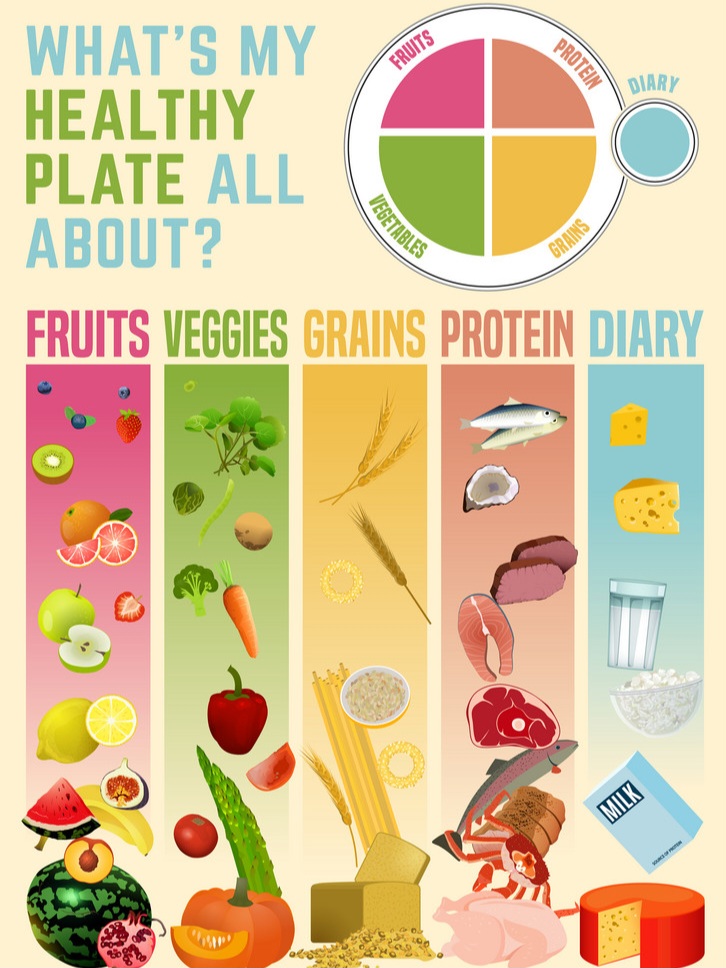The Healthy Eating Plate is a simple way of visualizing a healthy diet by dividing the plate up like a pie chart based on food groups. The Healthy Eating Plate can be divided into as little as 5 basic components:
- Dedicate a quarter of the plate to whole grains: Whole grains include whole wheat, quinoa or brown rice as they are rich in fiber and complex carbohydrates.
- Fill half of your plate with fruits and vegetables: About ½ of the plate should consist of fruits and vegetables. Diversifying the vegetables is most important as they provide minerals and vitamins.
- Use oil in moderation: Healthy vegetable oils should be preferred but trans fats should be avoided wherever possible.
- Power up quarter plate with protein: Include beans, nuts, milk as they are healthier alternatives as compared to red or processed meat.
- Avoid sugary drinks: The sugary soda or soft drinks can lead to imbalanced diet. Sticking to water or fruit drinks can help you staying hydrated.

The science of Ayurveda not only encompassed detailed medical science but also emphasized nutrition, work-out and other aspects to promote the physical as well as mental well-being. The food practices according to Ayurveda focus ton individualization to match the elements of existence and body type. Ideally, meals are supposed to have all six tastes: sweet, sour, salty, pungent, bitter and astringent. Traditionally, people in India sat down comfortably on the ground to have their meals along with the entire family.
According to Ayurveda, poor digestion is the main factor behind poor health but healthy digestion is like a strong and steady fire that transforms food into easily absorbed nutrients and easily eliminated waste.
Some principles of Ayurveda for Healthy Eating Plate are:
- Make lunch your biggest meal: The digestive fire is at peak in the afternoon because the sun reaches its highest point so Ayurveda recommends eating the largest meal of the day at noon so that food is properly digested and assimilate.
- On the contrary, eat a light and well-cooked meal at least three hours before going to bed in the night.
- Eating a heavy meal late in the evening can put extra burden on the digestive system because night is the time for rest and repair for the body.
- Be Spice wise: Spices not only add flavour and aroma to the food but they bring therapeutic value to the meal as well.
- They also help in building immunity as they help in digestion so that the body can absorb and assimilate the nutrients from food.
- Eat in proper quantity: Food taken in proper quantity will not aggravate the doshas. In fact, it will enhance the quality and increase life span.
- It will easily pass down to the rectum.
- The food taken in proper quantity does not impair the power of digestion and also gets easily digested.
- It will also enhance the agni (digestive fire).
- Eat food which is not contradictory in potency: If a person consumes foods which are mutually contradictory in terms of veerya or potency, then one would easily suffer from many diseases in future.
- For example, one should not take milk with fish together because they are veerya viruddh ahara i.e., they have contradictory potencies. Milk has sheeta veerya (cold potency) whereas fish is of ushna veerya (hot potency).
- When they are consumed together, they have dangerous effect on the body.
- Eat only after the food taken previously has been digested: One should consume food which has been properly digested as the new food gets added to the undigested food and form a vicious mixture.
- As a result, there will be further aggravation of doshas leading to the manifestation of various diseases.
Food to be consumed habitually:
As per Ayurveda, the following foods can be consumed habitually:
- Wheat
- Barley
- Pointed gourd
- Green gram
- Desi ghee
- Milk
- Honey
Foods not to be consumed habitually:
- Fermented gruel
- Uncooked radish
- Fish
- Dry meat
Food combinations to avoid in healthy eating plate:
- Milk and fruits should not be mixed.
- Avoid eating milk products with animal protein such as milk and eggs, fish and cream etc.
- Milk should not be taken with radish, cherries, melons, fish, citrus fruits.
- Favour a vegetarian diet. Fruits and vegetables are valued in Ayurveda not only for their nutritive value but they are good cleansers as well.
- The whole foods should be eaten instead of processed foods, leftovers or raw foods because whole foods promote ojas. Foods that are overly processed, frozen or canned are hard to digest and lack nutrients. So, it’s better to avoid junk food.
- Raw foods such as whole foods are harder to digest. For this reason, Ayurveda generally favours well-cooked, lightly spiced veggies over raw salads.
- Ice-cold foods are also better avoided as they diminish the digestive fire.
Eating not only nourishes the body but nourishes the mind as well so healthy eating plate make eating more beneficial for the body as well as enjoyable.
Disclaimer:-
This article is not a substitute to the standard Medical Diagnosis or personalized Ayurvedic Treatment! It is intended only for Information!
For experts consultation, please write us at care@blessayurveda.com
1,439 total views, 4 views today